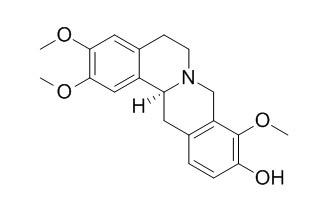Corydalmine
Corydalmine exhibits antibacterial activities against Staphylococcus aureus and methicillin-resistant S. aureus strains.1-Corydalmine significantly inhibits spore germination of all the fungi at 100 to 1500 ppm. l-Corydalmine also exhibits potent analgesic activity in preclinical models, it is under development as an oral analgesic agent.
Inquire / Order:
manager@chemfaces.com
Technical Inquiries:
service@chemfaces.com
Tel:
+86-27-84237783
Fax:
+86-27-84254680
Address:
1 Building, No. 83, CheCheng Rd., Wuhan Economic and Technological Development Zone, Wuhan, Hubei 430056, PRC
Providing storage is as stated on the product vial and the vial is kept tightly sealed, the product can be stored for up to
24 months(2-8C).
Wherever possible, you should prepare and use solutions on the same day. However, if you need to make up stock solutions in advance, we recommend that you store the solution as aliquots in tightly sealed vials at -20C. Generally, these will be useable for up to two weeks. Before use, and prior to opening the vial we recommend that you allow your product to equilibrate to room temperature for at least 1 hour.
Need more advice on solubility, usage and handling? Please email to: service@chemfaces.com
The packaging of the product may have turned upside down during transportation, resulting in the natural compounds adhering to the neck or cap of the vial. take the vial out of its packaging and gently shake to let the compounds fall to the bottom of the vial. for liquid products, centrifuge at 200-500 RPM to gather the liquid at the bottom of the vial. try to avoid loss or contamination during handling.
Food Chem Toxicol.2020, 135:110863
Integr Med Res.2021, 10(3):100723.
J Ethnopharmacol.2016, 194:219-227
Journal of Functional Foods2023, 104:105542
Food Research2021, 5(1):65-71
Mol Biol Rep.2024, 51(1):117.
Plant Physiol.2024, 194(4):2580-2599.
Int J Mol Sci.2022, 23(20):12516.
Chem Biol Interact.2019, 298:1-7
Foods.2021, 10(11):2754.
Related and Featured Products
J Asian Nat Prod Res. 2013;15(3):315-8.
A new antibacterial denitroaristolochic acid from the tubers of Stephania succifera.[Pubmed:
23418880]
METHODS AND RESULTS:
A new denitroaristolochic acid, demethylaristofolin C (1), together with six known alkaloids, crebanine N-oxide (2), (-)-sukhodianine-β-N-oxide (3), palmatine (4), Corydalmine (5), dehydroCorydalmine (6), and corynoxidine (7), was isolated from the tubers of Stephania succifera. The structure of demethylaristofolin C was elucidated by spectroscopic techniques (UV, IR, 1D, and 2D NMR) and HR-ESI-MS analyses.
CONCLUSIONS:
These compounds exhibited antibacterial activities against Staphylococcus aureus and methicillin-resistant S. aureus strains in different degrees.
Mycobiology. 2007 Jun;35(2):69-71.
Effect of 1-corydalmine,an Alkaloid Isolated from Corydalis chaerophylla Roots on Spore Germination of Some Fungi.[Pubmed:
24015073]
METHODS AND RESULTS:
1-Corydalmine,an alkaloid isolated from roots of Corydalis chaerophylla inhibited spore germination of some plant pathogenic as well as saprophytic fungi e.g. Alternaria brassicae, A. brassicicola, A. solani, Curvularia lunata, C. maculans, C. sp., C. pallscens, Erysiphe pisi, Fusarium udum, Helminthosporium species,H. penniseti and a Heterosporium species.
CONCLUSIONS:
1-Corydalmine significantly inhibited spore germination of all the fungi at 100 to 1500 ppm. It was effective against all the fungi at 1500 ppm. C. lunata was highly sensitive to this chemical even at 250 ppm.
J Pharm Biomed Anal. 2016 Sep 5;128:98-105.
In vitro metabolism of l-corydalmine, a potent analgesic drug, in human, cynomolgus monkey, beagle dog, rat and mouse liver microsomes.[Pubmed:
27239758]
l-Corydalmine (l-CDL) was under development as an oral analgesic agent, exhibiting potent analgesic activity in preclinical models.
METHODS AND RESULTS:
The objective of this study was to compare metabolic profiles of l-CDL in liver microsomes from mouse, rat, monkey, dog and human. Six metabolites (M1-M6) were identified using LC-Q/TOF in liver microsomes from the five species. The metabolism of l-CDL included O-demethylation (M1-3) and hydroxylation (M4-6). The desmethyl metabolites were the major ones among the five species, which accounted for more than 84%. Data from chemical inhibition in human liver microsomes (HLM) and human recombinant CYP450s demonstrated that CYP2D6 exhibited strong catalytic activity towards M1 and M2 formations, while CYP2C9 and CYP2C19 also catalyzed M2 formation. Formations of M3 and hydroxyl metabolites (M4 and M5) were mainly catalyzed by CYP3A4. Further studies showed that M1 and M2 were main metabolites in HLM. The kinetics of M1 and M2 formations in HLM and recombinant CYP450s were also investigated. The results showed that M1 and M2 formations in HLM and recombinant CYP2D6 characterized biphasic kinetics, whereas sigmoid Vmax model was better used to fit M2 formation by recombinant CYP2C9 and CYP2C19. The contributions of CYP2D6 to M1 and M2 formations in HLM were estimated to be 75.3% and 50.7%, respectively. However, the contributions of CYP2C9 and CYP2C19 to M2 formation were only 5.0% and 4.1%, respectively.
CONCLUSIONS:
All these data indicated that M1 and M2 were main metabolites in HLM, and CYP2D6 was the primary enzyme responsible for their formations.



